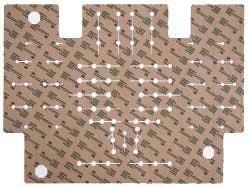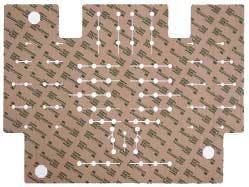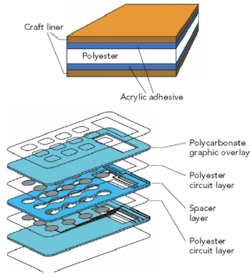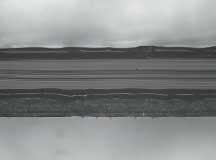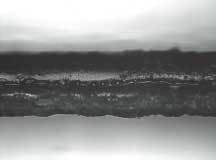Laser systems are a logical choice for both prototyping and short run production of membrane switches due to the elimination of tooling costs and their rapid turnaround time. However, in production, the majority of membrane switches are produced using flatbed dies because of the inherent productivity advantages with die cutting. The laser beam has to traverse the entire die line while the die will produce the part with the stroke of the press. Conventional motion laser systems lack the processing speed to compete with die-cut parts.
Enter laser digital converting—a technology that greatly expands the economic lot quantity from prototyping and short run production to medium and long production runs so that it is now possible to outperform, with greater accuracy, a flatbed die press. To put this in perspective, with a laser a membrane switch manufacturer can output the same production while eliminating all steel-rule dies, die storage, die maintenance, and die set-up on the press for short and medium production runs. In addition, modifications and engineering changes to the part can be accomplished through the operator interface terminal, eliminating the need to rework or purchase a new die.
Compared to conventional XY gantry or flying optic systems, laser digital converting can process the material 20 times faster, even when the same laser power is used to process the part.
Laser digital converting technology uses the same sealed diffusion-cooled lasers as found on conventional cutting systems, the difference being three-axis galvanometer scan heads and sophisticated control software to direct the beam. The galvanometer motion allows processing at higher speeds due to the low inertia of the motion system when compared to standard laser processing systems. In addition, the jump speeds are 60 times faster than conventional systems resulting in a high percentage of laser on time during material processing.
The processing area of the scan head is typically limited to 13.7-in. square fields to maintain a small focused spot on the work piece. Because most sheets processed in the membrane switch market exceed this dimension, X- and Y-axis linear motion is used to index the sheet under the scan head, a solution that allows full-size sheets to be 'tiled' on the system (see Figure 1). This tiling capability allows the user to eliminate any edge taper by defining the tile size during the file preparation phase.
An example of this technology is the WorkStation XY produced by LasX Industries Inc. (St. Paul, MN). The WorkStation XY incorporates the company's LaserSharp digital converting technology for high-speed beam manipulation and linear motors that are used for tiling sheets up to 30 in. x 42 in. A 300W sealed diffusion-cooled CO2 laser offers a good balance between price and processing speed for materials commonly found in the membrane switch market.
When die-cutting with steel rule dies, the sheet is typically registered by hard stops placed on the mechanical press. When it is important for the die-cut parts to be registered to the screen-printing, this registration method is problematic because the part edge is being referenced and not the print. Another problem encountered with screen-printed parts is the inherent distortion that occurs in the screen-printing process. Because these distortions cannot be controlled, it is not possible to produce a die that will match the print across the entire screen area. As a result, a common practice in precision screen-printing is to only print in a small area or sweet spot on the screen press. This is the only way the printer is assured the die can be registered to the print during the die-cutting operation.
A critical component of any membrane switch is the spacer layer that provides the physical separation between the conductive screen-printed polyester layers in addition to sealing and bonding the circuit layers. The spacers consist of a center polyester sheet with an acrylic adhesive laminated to each side (see Figure 2). A craft paper release liner protects the adhesive until the membrane switch is assembled. A membrane switch relies on the acrylic adhesive to bond the individual layers together and any problems with the adhesive may result in a switch failure. It was important for the membrane switch market to be assured that no product performance problems would be encountered by using laser digital converting technology to produce the spacers.
3M's Adhesive Division developed a test program to ensure no adverse results would occur using the laser process. European membrane switch manufacturers were pressing 3M to study the composition of the vapors produced during laser processing to ensure there would be no long-term effects to their employees if the spacers were laser cut. The close proximity of LasX to 3M allowed 3M industrial hygienists to set up their test equipment at LasX and perform cutting trials, capturing the smoke produced by laser processing.
Phase I test collection was for the worst case, with the source sample being taken at the face opening of the exhaust duct and in the breathing zone 20 in. above the cutting surface. Phase II collection was taken 6-8 inches from the processing area, and the breathing zone sample was from a collector worn by the operator in the breathing zone. The samples were analyzed for dust, organic compounds, organic acids, oxides of nitrogen, volatile organic compounds (VOCs), and carbon monoxide. All the results indicated the contaminants were below the analytical detection limits and any adverse health effects would not be expected. In addition, all the tests were performed using a CDRH Class IV laser configuration. One would expect even lower exposures for Class I configurations.
With health concerns eliminated, the 3M study turned toward product performance. For laser digital converting to be a viable production process, any concerns regarding spacer use and performance needed to be studied and compared to mechanically cut spacers. Spacer samples that were knife cut and laser cut were submitted to 3M for analysis. Figure 3 is a microphotograph of the knife cut cross-section and Figure 4 is the laser cut cross-section. While the knife cut edge is visually cleaner, peel tests were performed and it was determined there was no product performance difference between the two different processes.
Laser digital converting does offer the membrane switch manufacturer some distinct processing advantages. Because the laser vaporizes the spacer laminate a kerf is produced, resulting in a space between the part and the slug. This does not happen with knife or die cutting as the material is simply displaced. As a result, knife or die cut parts need to be manually 'de-slugged' because the adhesive in the spacer will 'heal' and not allow the slug to drop freely. This is not the case with laser digital converting and a costly manual secondary operation can be avoided. In addition, the laser cauterizes the adhesive edge, reducing the adhesive flow and bleeding common to mechanically cut edges. This testing indicates a laser cut spacer is equivalent in performance to a mechanically cut spacer with the laser cut spacer actually offering productivity advantages.
Laser digital converting is also an ideal solution for polycarbonate graphic overlays and the conductive screen-printed polyester layers that make up a membrane switch. The polyester layers process well with the laser, however the polycarbonate can be problematic due to the surfaces discoloring when laser processing. It is important to mask the top surface with a low tack paper masking such as a 3M SCPS-2 pre-spacing tape to protect the overlay face from any discoloration. While this step requires additional time and expense for part masking, the productivity gain realized using laser digital converting more than offsets this added expense.
Laser digital converting also offers additional benefits for processing the latest generation membrane switch designs. Product miniaturization is driving the membrane switch 'tail' or terminal interconnects to smaller pitch end pads. The registration of the pads to the cut tail edge is critical for the assembly of the end connector. Tolerances of the print to part can be as tight as ± 0.003 in., which is not possible for steel rule dies to produce on a consistent basis. Using a vision system, printed registration marks can be placed near the tails and acquired by the registration cameras resulting in producing the tight registration demanded by this process.
Another process that is well suited for laser digital converting is via hole drilling for high-performance polyester flex circuits. Flatbed dies to produce the via holes can be expensive and problematic. For redundancy, three holes are typically produced to ensure a good interconnect between the conductive layers. A common drawback to mechanically punching via holes is producing a tear in the polyester between adjacent via holes due to the stress induced with the punching operation. Also, because via holes are typically 0.006 in. to 0.010 in. diameter, the punches are quite fragile and prone to break. Laser digital converting is an ideal application for via hole production because it is a non-contact process. Additionally, it is possible to drill via holes at more than 100 via holes per second for cost effective processing of these critical features.
Laser digital converting can dramatically improve productivity and reduce costs for the membrane switch manufacturer. The improved productivity offered with galvanometer processing technology enhances the return on investment. The increase in production throughput compared to conventional laser cutting systems will yield cost-down benefits to the user. Because material is processed in less time, at a lower cost, the membrane switch manufacturer can also convert production currently performed using steel-rule dies to a laser digital converting system. No longer will die set-up, storage, or maintenance eat away at the bottom line. The membrane switch manufacturer can now respond quickly and cost effectively to market demands without absorbing the costs associated with hard tooling.
John Dillon is vice president of sales for LasX Industries Inc. (www.laserxindustries.com), and Bruce Penman has recently retired as division scientist at 3M's Adhesive Division.
